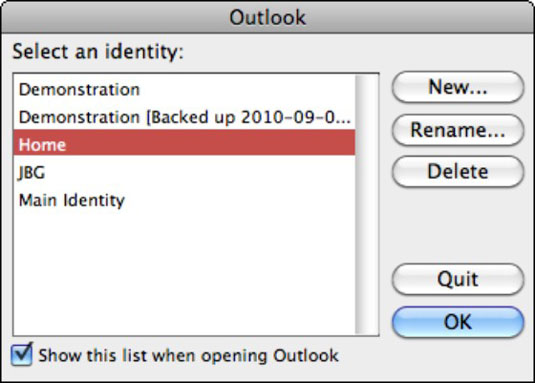Outlook For Mac Identity
Hi I'm Cara, a Carbonite expert. I can walk you through this process!
Outlook 2016 For Mac Identity Location
- Rebuild Complete Mac Outlook Database. Outlook Mac Recovery Software has an inbuilt feature that extensively scans the Mac MS Outlook or Office 365 profile/identity and recovers its data items. The profile can be identified automatically by the software from its respective default location.
- Note: The ability to manually repair or rebuild a database is not available in Outlook 2016 for Mac.If a problem such as Outlook data corruption occurs, Office 2016 for Mac automatically repairs and rebuilds the Office database for you. For more information, see About the Office 2016 for Mac database.
- An Outlook for Mac 2011 identity can only be imported into an empty Outlook 2016 for Mac profile. An empty profile is one where accounts or other data have yet to be added. We suggest you create a new empty profile in Outlook 2016 for Mac using the Outlook.
- Set up Exchange account access using Outlook for Mac. If you have Outlook for Mac, you can use it to access your Exchange account. See Add an email account to Outlook for instructions. Set up Exchange account access using Mac OS X 10.10 or later. If you're running Mac OS X version 10.10 or later, follow these steps to set up an Exchange email.
- This article is for Mac - View the Windows article
Microsoft stores your Outlook information in data files. These files contain all the emails, contacts, calendar events, etc. that you see in Outlook.
Switch to an annual subscription and enjoy the full power of Microsoft 365 for 16% less than paying monthly. Switch to an annual subscription and enjoy the full power of Microsoft 365 for 16% less than paying monthly. One convenient subscription for up to 6 people. Includes AI-powered apps, up to 6.
Depending on your version of Outlook, Microsoft stores the data in the following locations by default:
Viruses for mac os x. Malicious software). A phishing scam has targeted Mac users by redirecting them from legitimate websites to fake websites which tell them that their computer is infected with a virus. The user is then offered Mac Defender 'anti-virus' software to solve the issue.This “anti-virus” software is malware (i.e.
| Outlook Version | Outlook Data Location |
|---|---|
| Outlook 2016 |
|
| Outlook 2011 |
|
Importing an .OLM File into Outlook 2016
An .OLM file is the data file used by Outlook for Mac to archive your email messages, contacts, calendar items, tasks, and notes. Keypad for macbook pro. To import the file into Outlook:
- Open Outlook and click Tools; Import.
- In the Import window, select Outlook for Mac archive file (.OLM) and click Continue.
- Browse to the location of the .OLM file you restored and click Import.
Your e-mails, notes, calendar items, contacts, and Outlook journal entries will be restored. You can repeat this process for another .OLM file.

Importing Identities from Outlook 2011 into Outlook 2016
A profile, also known as an identity in Outlook for Mac 2011, is the set of data contained in Outlook that includes accounts, email messages, contacts, calendar items, tasks, notes, categories, rules, and signatures. Outlook 2016 for Mac supports importing Outlook for Mac 2011 identities, a process typically used when upgrading from Outlook 2011 to Outlook 2016 for Mac.
Restoring Outlook For Mac Identity
- Open Outlook and click Tools; Import.
- In the Import window, select Outlook 2011 data on this computer and click Continue.
- Browse to the location of the identity you restored and click Continue.
This will restore your e-mails, notes, calendar items, contacts, and Outlook journal entries. You can repeat this process for another Outlook profile.
Create New Identity Mac Outlook
For additional information about importing email messages, contacts, and other items into Outlook 2016, please review this Microsoft Support article.
